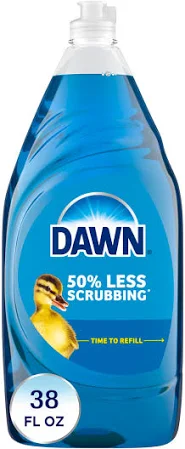Looking to improve the head/foam of a couple of recipes that have almost no caramel/crystal malts... What do you use to get better foam?
You are using an out of date browser. It may not display this or other websites correctly.
You should upgrade or use an alternative browser.
You should upgrade or use an alternative browser.
best grain for foam?
- Thread starter Hoochin'Fool
- Start date

Help Support Homebrew Talk:
This site may earn a commission from merchant affiliate
links, including eBay, Amazon, and others.
Chit malt and wheat is what I use. Also and extended rest 162° before I head to mashout.
Halfakneecap
Well-Known Member
Chit malt at 3% gives my rice lagers very good lacing. And also the 162f rest helps too
Remnds me im out of chit malt. Need to reorder
Remnds me im out of chit malt. Need to reorder
Last edited:
worlddivides
Well-Known Member
Flaked wheat gets my vote.
Halfakneecap
Well-Known Member
I don't use special malts, all my beers have nice lasting foam heads.
Didn't take long

$53.24
1pc Hose Barb/MFL 1.5" Tri Clamp to Ball Lock Post Liquid Gas Homebrew Kegging Fermentation Parts Brewer Hardware SUS304(Liquid Hose Barb)
yunchengshiyanhuqucuichendianzishangwuyouxiangongsi

$49.95 ($0.08 / Fl Oz)
$52.99 ($0.08 / Fl Oz)
Brewer's Best - 1073 - Home Brew Beer Ingredient Kit (5 gallon), (Blueberry Honey Ale) Golden
Amazon.com

$176.97
1pc Commercial Keg Manifold 2" Tri Clamp,Ball Lock Tapping Head,Pressure Gauge/Adjustable PRV for Kegging,Fermentation Control
hanhanbaihuoxiaoshoudian

$53.24
1pc Hose Barb/MFL 1.5" Tri Clamp to Ball Lock Post Liquid Gas Homebrew Kegging Fermentation Parts Brewer Hardware SUS304(Gas MFL)
Guangshui Weilu You Trading Co., Ltd

$76.92 ($2,179.04 / Ounce)
Brewing accessories 1.5" Tri Clamp to Ball Lock Post Liquid Gas Homebrew Kegging Fermentation Parts Brewer Hardware SUS304 Brewing accessories(Gas Hose Barb)
chuhanhandianzishangwu

$20.94
$29.99
The Brew Your Own Big Book of Clone Recipes: Featuring 300 Homebrew Recipes from Your Favorite Breweries
Amazon.com

$22.00 ($623.23 / Ounce)
AMZLMPKNTW Ball Lock Sample Faucet 30cm Reinforced Silicone Hose Secondary Fermentation Homebrew Kegging joyful
无为中南商贸有限公司

$33.99 ($17.00 / Count)
$41.99 ($21.00 / Count)
2 Pack 1 Gallon Large Fermentation Jars with 3 Airlocks and 2 SCREW Lids(100% Airtight Heavy Duty Lid w Silicone) - Wide Mouth Glass Jars w Scale Mark - Pickle Jars for Sauerkraut, Sourdough Starter
Qianfenie Direct

$33.98
DYKWSWYX Heavy Duty Brewing Gloves (1 Pair) - 55CM Long Chemical Resistant Plastic Gloves for Beer & Wine Making, Cleaning, Homebrew Equipment Protection
wuhanshijiayangzhiyimaoyiyouxiangongsi

$44.99
$49.95
Craft A Brew - Mead Making Kit – Reusable Make Your Own Mead Kit – Yields 1 Gallon of Mead
Craft a Brew
![Craft A Brew - Safale S-04 Dry Yeast - Fermentis - English Ale Dry Yeast - For English and American Ales and Hard Apple Ciders - Ingredients for Home Brewing - Beer Making Supplies - [1 Pack]](https://m.media-amazon.com/images/I/41fVGNh6JfL._SL500_.jpg)
$6.95 ($17.38 / Ounce)
$7.47 ($18.68 / Ounce)
Craft A Brew - Safale S-04 Dry Yeast - Fermentis - English Ale Dry Yeast - For English and American Ales and Hard Apple Ciders - Ingredients for Home Brewing - Beer Making Supplies - [1 Pack]
Hobby Homebrew

$719.00
$799.00
EdgeStar KC2000TWIN Full Size Dual Tap Kegerator & Draft Beer Dispenser - Black
Amazon.com

$479.00
$559.00
EdgeStar KC1000SS Craft Brew Kegerator for 1/6 Barrel and Cornelius Kegs
Amazon.com

$58.16
HUIZHUGS Brewing Equipment Keg Ball Lock Faucet 30cm Reinforced Silicone Hose Secondary Fermentation Homebrew Kegging Brewing Equipment
xiangshuizhenzhanglingfengshop

$7.79 ($7.79 / Count)
Craft A Brew - LalBrew Voss™ - Kveik Ale Yeast - For Craft Lagers - Ingredients for Home Brewing - Beer Making Supplies - (1 Pack)
Craft a Brew

$172.35
2 Inch Tri Clamp Keg Manifold With Ball Lock Posts, Pressure Gauge, PRV (0-30 PSI) – Homebrew, Fermentation, Kegging System
wuhanshijiayangzhiyimaoyiyouxiangongsi
A mashout of 172* is all you need for dense, lasting foam.
Is there some scientific backing for this, or just a personal anecdote??A mashout of 172* is all you need for dense, lasting foam.
For the OP, my grain choice is malted Rye.
Try Carafoam, not Carapils/Dextrine. Most places say they are the same, but that hasn't been my experience over the years when I have substituted them. You don't need much, 3-4 oz for a 5g batch.
Barão
Well-Known Member
- Joined
- Jun 18, 2020
- Messages
- 191
- Reaction score
- 50
According to Charlie Banforth...foam expert.... https://beersmith.com/blog/2021/02/28/beer-foam-with-dr-charlie-bamforth-beersmith-podcast-231/
Attachments
FloppyKnockers
Well-Known Member
Taste like crap, but you get head retention for days.


Is this to be used before the boil or after?Taste like crap, but you get head retention for days.
homebrudoc
Well-Known Member
Foam stand rest at 160 deg F and some flaked barley
homebrudoc
homebrudoc
fluketamer
Well-Known Member
- Joined
- Dec 1, 2008
- Messages
- 1,949
- Reaction score
- 2,560
so many different answers . i have tried many of the mentioned techniques but carapils still gets my vote . 4 oz per 5 gallons.
however for really great foam - nothing beats maltodextrin .
however for really great foam - nothing beats maltodextrin .
Remnds me im out of chit malt.
No chit?
Barão
Well-Known Member
- Joined
- Jun 18, 2020
- Messages
- 191
- Reaction score
- 50
Go learnso many different answers . i have tried many of the mentioned techniques but carapils still gets my vote . 4 oz per 5 gallons.
however for really great foam - nothing beats maltodextrin .
Attachments
fluketamer
Well-Known Member
- Joined
- Dec 1, 2008
- Messages
- 1,949
- Reaction score
- 2,560
thanks thats an interesting chart unfortunately i only brew with about half those malts.Go learn
and
IN MY EXPERIENCE,
i havent noticed a difference between vienna or munich in terms of foam.
and IMO
carapils has given me better results.
Last edited:
Black patent, that an interesting one.
Yeah, I think that chart got a few names switched around. Carapils the lowest, with black patent and roasted barley the top two? I'm calling shenanigans.
Technology Brewing and Malting, 5th edition page 226 has a mash program for well modified malts that ends at 172*. Further reading states that if mashout is not achieved the continuing starch degradation will affect foam stability.Is there some scientific backing for this, or just a personal anecdote??
For the OP, my grain choice is malted Rye.
I also like malted rye for stability and mouth feel.
Barão
Well-Known Member
- Joined
- Jun 18, 2020
- Messages
- 191
- Reaction score
- 50
I always use 5% wheat malt in all brews...it increases foam retention.thanks thats an interesting chart unfortunately i only brew with about half those malts.
and
IN MY EXPERIENCE,
i havent noticed a difference between vienna or munich in terms of foam.
and IMO
carapils has given me better results.
Prefer carapils over carafoam. Some wheat malt also does a beautiful job and adds some delicate flavor notes.
fluketamer
Well-Known Member
- Joined
- Dec 1, 2008
- Messages
- 1,949
- Reaction score
- 2,560
i have no clue and i think there are prolly multiple variables involved. its possible that the chart is right , but, if that experiment wasnt done on my system by me in my yard or the kitchen when the wife is generous enough to take out the kids, (especially my lovely princess daughter who is particualrly fond of screaming wtf is that smell - even tho your 22! and should be out of the house by now!) then i am better off continuing to brew with different ingredients and take notes and go from there.Yeah, I think that chart got a few names switched around. Carapils the lowest, with black patent and roasted barley the top two? I'm calling shenanigans.
yeah i been drinking at noon again
On what sort of system? Mashout is always achieved... on the way to boiling. How much time is there for continuing starch degradation with full volume BIAB for instance?Technology Brewing and Malting, 5th edition page 226 has a mash program for well modified malts that ends at 172*. Further reading states that if mashout is not achieved the continuing starch degradation will affect foam stability.
There is hope. My eldest is 43. She moved back in a few yers ago, stayed a year, bought her own place and moved back out. She loves the smell and helping with brew day. She is also the reason I often say “But why is the beer gone”i have no clue and i think there are prolly multiple variables involved. its possible that the chart is right , but, if that experiment wasnt done on my system by me in my yard or the kitchen when the wife is generous enough to take out the kids, (especially my lovely princess daughter who is particualrly fond of screaming wtf is that smell - even tho your 22! and should be out of the house by now!) then i am better off continuing to brew with different ingredients and take notes and go from there.
yeah i been drinking at noon again
You should read the book!On what sort of system? Mashout is always achieved... on the way to boiling. How much time is there for continuing starch degradation with full volume BIAB for instance?
System not specified but most likely a 3 or 4 vessel.
We are going to see if this holds water because I did a decoction mash on a Munich Dunkle and had the burner on low and it sat at 170* for around 15 min.
Define foam. Does it mean head retention? If it does don’t marry Henry the Eighth.
- Joined
- Feb 16, 2012
- Messages
- 4,642
- Reaction score
- 7,061
- Location
- At home, in the brewery in Maryland.
172F seems a bit low. I usually mash out at 176-178F.Technology Brewing and Malting, 5th edition page 226 has a mash program for well modified malts that ends at 172*. Further reading states that if mashout is not achieved the continuing starch degradation will affect foam stability.
I also like malted rye for stability and mouth feel.
- Joined
- Aug 31, 2017
- Messages
- 167
- Reaction score
- 142
Ever poured a glass of Guiness?Yeah, I think that chart got a few names switched around. Carapils the lowest, with black patent and roasted barley the top two? I'm calling shenanigans.
Barão
Well-Known Member
- Joined
- Jun 18, 2020
- Messages
- 191
- Reaction score
- 50
Yeah, for real.I don't use special malts, all my beers have nice lasting foam heads.
This dude has, hands down, the best head on the forum. When he talks, listen.
Carapils is not a scam, brulosophy is a joke imo. But I just made a latte with great foam, no carapils, some booze added.. so who knows. Man I'm wired.
- Joined
- Feb 16, 2012
- Messages
- 4,642
- Reaction score
- 7,061
- Location
- At home, in the brewery in Maryland.
So what's the verdict for better head retention without residual cloudiness of wheat or oats? Is chit malt the latest key to better head? Hhmm... I'm gonna' hafta' look into this....
Ever poured a glass of Guiness?
Yes I have. But I doubt it's the dark roasted malts driving that head. More likely the unmalted barley they use.
Last edited:
The chart correctly reports the experiments done. In discussing it, Charlie in fact goes out of his way to mention that Carapils — marketed specifically to enhance foam — gives worse foam than anything else.Yeah, I think that chart got a few names switched around. Carapils the lowest, with black patent and roasted barley the top two? I'm calling shenanigans.
That said, in my personal opinion, the experiment has been simplified too much. That bad foam is from a 100% Carapils grist, and I think it’s hard to extrapolate from that to normal usage.
Then again, the man developed an ASBC method to measure foam quantitatively, and then went into his lab to make measurements.
TL;DR:
The book says that foam positives are
- Carbonation level
- Nitrogen
- Amount of malt
- Amount of iso-alpha-acids
- Wheat malt
- Roasted malts
- Additional zinc at packaging
Given that most of these things are fixed by recipe, the easy fixes are adding a portion of wheat malt, and adding zinc.
- Joined
- Feb 16, 2012
- Messages
- 4,642
- Reaction score
- 7,061
- Location
- At home, in the brewery in Maryland.
Does chit malt work? Is it superior to CaraPils/CaraFoam? Will the finished beer have a permanent haze? What's the ultimate effect on the desired clarity on my Unicorn Kolsch? Am I being counter-productive to add chit malt to the grist for foam stability and head retention, and then later attempt to clarify with Biofine?
It seems like there are mutually exclusive goals at play. All I want to do is have a thick white foamy head on a crystal clear stange of Kolsch.
(note: sorry for the double post, here and on another "chitty" thread)
It seems like there are mutually exclusive goals at play. All I want to do is have a thick white foamy head on a crystal clear stange of Kolsch.
(note: sorry for the double post, here and on another "chitty" thread)
Barão
Well-Known Member
- Joined
- Jun 18, 2020
- Messages
- 191
- Reaction score
- 50
It's thereCarapils is not a scam, brulosophy is a joke imo. But I just made a latte with great foam, no carapils, some booze added.. so who knows. Man I'm wired.
Attachments
Well I've used it for years, my beers have good body, foam, and head retention, maybe it's more process related then it due to carapils, but for an extra $.20 per pound over regular 2row it certainly isn't hurting anything, and if they scammed me for 20 cents, well shucks.
G_robertus
Well-Known Member
Have you read the paper? I'm not saying there isn't any truth to it, but I would hardly call this graph an accurate representation of the effects of these grains in beer. The authors did not make beer when testing foam for most of these ingredients, rather boiled grain extract (like AlexKay also mentioned). Unhopped, no base malt, no fermentation. It might very well be possible that this can be translated into beer, but there is no evidence for that and they haven't done that when making this graph. It should also be noted that the carapils used in the paper is the American brand, not the German version. I'm still undecided whether it actually does anything and it's on the long list of things to test. It doesn't seem foam negative at least.It's there
The time lapse in the Brulosophy piece is not synchronised well, but it seems as if the German stuff has marginally better foam qualities from what I can tell. The foam seems to drop slower, but you can't really tell from the way they've set it up. They tend to draw weird conclusions and perform bad science, so I wouldn't trust them anyway.
To OP's question: wheat malt, chit malt, rye, step mashing and tetrahop work very well for foam in my experience (and none are listed). For grain additives you need quite a bit though. Tetrahop is the easiest way I've seen up to now and it still works even when it loses its bittering qualities. Raw wheat/flakes only when used in adequate amounts. Flaked barley was somewhat disappointing and I was therefore very surprised chit seemed to work so well. Oats are detrimental for foam in larger quantities. Oat malt is a bit better than raw oats. Corn, rice and sugar are bad for foam. I think millet didn't work too well either. Spelt is also something I have yet to test.
My understanding on tetra is that it's great for foam formation and retention, but can give bad foam aesthetics, in particular iceberg-like clumps.To OP's question: wheat malt, chit malt, rye, step mashing and tetrahop work very well for foam in my experience (and none are listed). For grain additives you need quite a bit though. Tetrahop is the easiest way I've seen up to now and it still works even when it loses its bittering qualities. Raw wheat/flakes only when used in adequate amounts. Flaked barley was somewhat disappointing and I was therefore very surprised chit seemed to work so well. Oats are detrimental for foam in larger quantities. Oat malt is a bit better than raw oats. Corn, rice and sugar are bad for foam. I think millet didn't work too well either. Spelt is also something I have yet to test.
I don't think sugar (or corn or rice) are bad for foam in and of themselves. It's more that they raise ABV without adding any soluble proteins, and ethanol is definitely foam-negative. So an all-malt barleywine can (sometimes) have decent foam, because there's a ton of protein to offset the ton of alcohol, but a similar-ABV tripel brewed with sugar adjuncts is likely to be worse in the foam department.
Similar threads
- Replies
- 20
- Views
- 1K
- Replies
- 5
- Views
- 374
- Replies
- 6
- Views
- 739












































